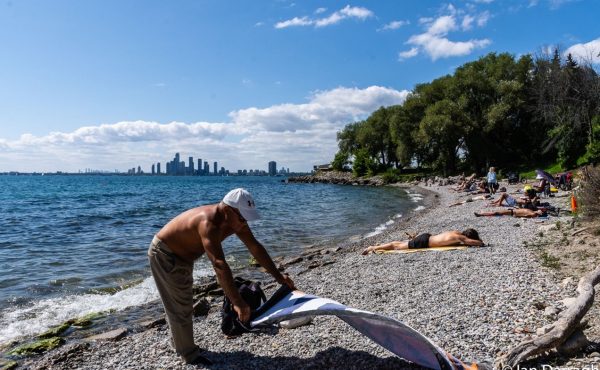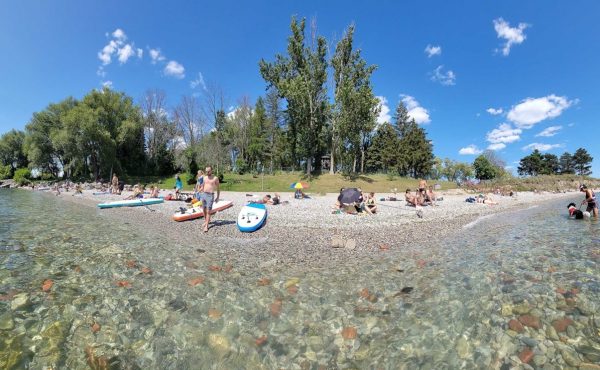
On Friday, we reported that the West 8 design team had won the competition to redesign our Waterfront. Here’s what some of the mainstream media had to say about the choice:
The Star‘s Christopher Hume writes that:
West 8 is a call to arms as well as an answer to a proposal call; it demands we wake up to the vast potential of the waterfront and take action — now.
 This emphasis on taking action now was reiterated at the official announcement Friday afternoon, when it was proposed that the southern part of Queen’s Quay be closed down this summer to let us to get an idea of what it will be like to have dedicated bicycle and pedestrian pathways.
This emphasis on taking action now was reiterated at the official announcement Friday afternoon, when it was proposed that the southern part of Queen’s Quay be closed down this summer to let us to get an idea of what it will be like to have dedicated bicycle and pedestrian pathways.
Over at the Globe & Mail, an interview with West 8 principal architect Adriaan Geuze reveals the thought process that lead to the simple but beautiful design:
“I asked my father, ‘What you think about Canada’s lakefront?’ and he said, “Lovely, great, beautiful lake views, forest and trees.”
 The National Post has a pair of articles which talk mainly about what was said at the announcement Friday. During her speech, jury member and University of Toronto Architecture, Landscape & Design Professor Brigitte Shim repeatedly emphasized that this design would be the easiest to implement quickly.
The National Post has a pair of articles which talk mainly about what was said at the announcement Friday. During her speech, jury member and University of Toronto Architecture, Landscape & Design Professor Brigitte Shim repeatedly emphasized that this design would be the easiest to implement quickly.
While the proposal calls for the closing of two lanes of Queen’s Quay Boulevard to create a pedestrian right-of-way, it does not require existing streetcar tracks to be moved. This will expedite the implementation of West 8’s plan.
The Post also praises the attention given to environmental detail in the West 8 design:
The plan does not work without clean water. West 8 wants to convert the vacant Soy Mill at the west end of the harbour into a 21st-century water filtration plant. It will clean the waste-water entering the harbour. The plant works hand-in-hand with a series of biofilters found along the harbour. The waterfront will no longer be an open sewer.
Steve Munro also describes the plan as one that “from a traffic engineering point of view, steps on a lot of toes.” He’s referring, of course, to the dismantling of the Gardiner and the reduction of Queen’s Quay. Because of the momentum and will to get this project (and others) under way, he suggests that “this could be the beginning of an era when we stop trying to accommodate the car everywhere.”
steps on a lot of toes.” He’s referring, of course, to the dismantling of the Gardiner and the reduction of Queen’s Quay. Because of the momentum and will to get this project (and others) under way, he suggests that “this could be the beginning of an era when we stop trying to accommodate the car everywhere.”
 It would be wrong not to acknowledge the jury’s thoughts on the other four entries, so here are some of their comments on the designs that didn’t quite make it:
It would be wrong not to acknowledge the jury’s thoughts on the other four entries, so here are some of their comments on the designs that didn’t quite make it:
WASAW’s design was too “reliant on intense programming from a vast array of cultural entities and [would] be difficult to implement and maintain year round in our climatic zone. A new vision for continuous water’s edge was not evident in this design submission.”
Tod Williams design proposed a new floating island that “would interfere with many current navigation routes and would visually separate the city from the water’s edge.”
Foster’s scheme had “new teardrop-like interventions [that] would interfere with the existing nautical shipping routes and recreation boating that currently takes place in our harbour.” [Side note: While this was being read, a man in a kayak who had pulled up to listen to the announcement broke out in applause].
PORT’s effort was considered the runner-up in the competition. Other than the clogging up of water traffic, the jury’s main criticism was that “the submission lacked the overall bold vision of a continuous waterfront that the competition brief articulated to clearly.”
For a complete catalogue of renderings, go to the West 8’s website here.



